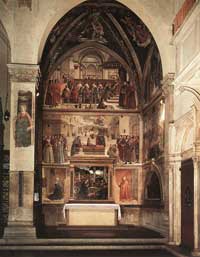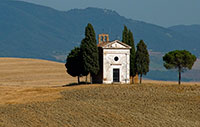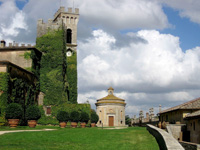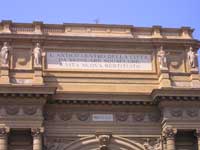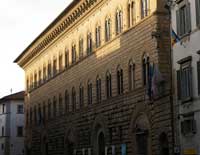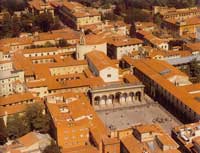Piazza della Repubblica |
|
Walking in Tuscany | Florence | Around Piazza della Repubblica |
| We start this tour from Duomo Square through Via Calzaioli to Orsanmichele. In front of Orsanmichele entrance there is the Palazzo dell’Arte della Lana which had been seat of this guild since 1308. |
||
| In front of this modern palace you can stop and touch the “porcellino” as Florentine people call a bronze copy of the marble statue of a wild boar by Pietro Tacca (1612) The original is in Uffizi Gallery. If you touch the snout you’ll have good luck and if you throw a coin into his mouth and it fells down into a grate you’ll come again to Florence! (you can try several times). Go on walking along Via Portarossa and arrive at Palazzo Davanzati (nr 13) the private palace perfectly preserved with its stone façade. This palace is so well preserved that became the museum of the old Florentine private house. You can visit it. Before arriving in Piazza Santa Trìnita, you see the Bartolini Palace, now hotel Portarossa with the Monaldi tower. As soon as you enter the irregular square, you are in front of the Justice column, a big monolith which comes from the Caracalla Thermal Baths in Rome and which was given by the Pope to Cosimo the 1st Medici. The square is rich in splendid palaces: Palazzo Bartolini Salimbeni by Baccio d’Agnolo (1520/23), Palazzo Buondelmonti and Palazzo Spini-Ferroni. In front of you there is the Santa Trìnita basilica, built in the second half of 11th century. The church was enlarged in 1300. The façade was made in 1593/94 by Bernardo Buontalenti. The church is famous for the Sassetti Chapel decorated in 1486 by Domenico Ghirlandaio with frescoes of the life of St Francis. Now go on in the street between Palazzo Buondelmonti and Palazzo Spini Ferroni, this street is Borgo SS. Apostoli. After a few meters the street enlarges in a nice little square with a ancient charming little church: Ss Apostoli (11th century) (description in “Churches” part) A side of the church The Altoviti Palace (1512) Proceeding in Borgo Ss. Apostoli, you can see the Rosselli del Turco Palace by Baccio d’Agnolo (1507). This area was hardly bombed in the last world war and many buildings were rebuilt after the war keeping the original volumes. Two ancient towers were not destroyed: the Baldovinetti tower (nr 4) and the Amidei Tower (nr 9 red) called “Bigonciola” and decorated with two lion heads of the Etruscantime. Now you are in Via Por Santa Maria, in front of you another little square with a nice church (usually closed): Santo Stefano in Ponte. Walk along via Por Santa Maria as far as Piazza della Repubblica, this square was rebuilt in 18 th century enlarging the ancient old market square which had been built over the Forum of the old Roman city. It is on the site, first of the city's forum and then of the city's old ghetto, which was swept away during the city improvement works or Risanamento initiated during the brief period when Florence was the capital of a reunited Italy, work that also created the city's avenues and boulevards. The ghetto's remains may still be seen in the square, as may the Mercato Vecchio, the Loggia del Pesce. Among the square's cafes, the Giubbe Rosse cafe has long been a meeting place for famous artists and writers, notably those of Futurism. Many famous bars are in this square: Le Giubbe Rosse or Gilli are the most famous. To the other side of the arch Via degli Strozzi starts: at nr 4 the Vecchietti Palace planed by Giambologna in 1578 but built much later. On the corner the copy of a bronze sculpture by Giambologna “The little devil” (the original one is in Palazzo Vecchio). |
||
| Go on and arrive in Strozzi Square where you can admire the grand Palazzo Strozzi. At nr 2 there is the Strozzino Palace which is a cinema now. Walking along the Strozzi Palace you arrive in Via Tornabuoni one of the most elegant streets in Florence with famous palaces and the best shops. Going to the Duomo on the right near the corner with Via Strozzi, you can find one of the oldest and most famous (for Florentine people, not for tourists) groceries of Florence: Procacci. Have a stop here, the shop is very little and there are only two or three little tables, here you can taste the best rolls with truffle in Florence and a good glass of wine in an intimate and suggestive place. At the end of Via Tornabuoni you can find Piazza Antinori with the Palace (Palazzo Antinori) built in1461/69 by Giuliano da Maiano. May be the name of this palace is familiar to you, because the Antinori Family produces many of the best Chianti wines. In front of the palace the church of San Gaetano. Before arriving in Duomo Square you can also visit Santa Maria Maggiore a medieval church and in front of it there is the palace of the hundred windows which, just for a change, now belongs to a bank. |
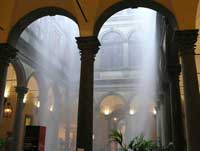 Strozzi Palace, courtyard |
|
|
Piazza della Repubblica |
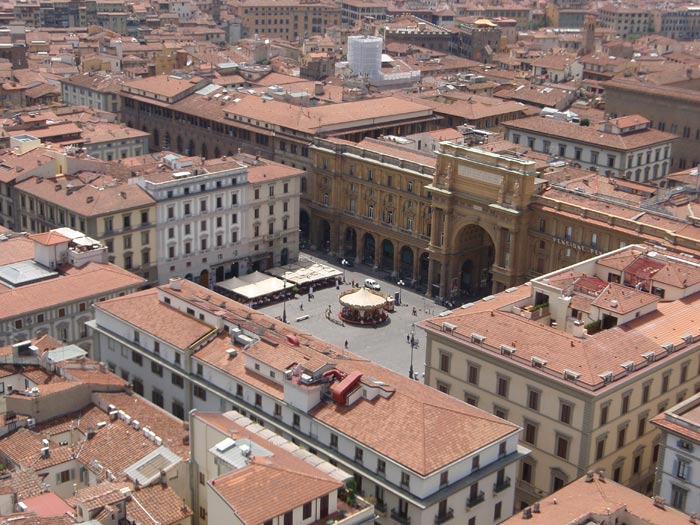 |
View of Piazza della Repubblica, from Giotto's Campanile |
Piazza della Repubblica is the largest square in Florence. It is located in one of the oldest sections of the town. The square was the site of the ancient Roman forum and some of its currently existing adjacent streets like: Via degli Strozzi, Via degli Speziali and Via del Corso configured the Decumanus Maximus, while Via Roma and Via Calimaia shaped the Cardus Maximus. In 1861, subsequent to the annexation of Tuscany to the Kingdom of Italy, was projected the flattening of the Mercato Vecchio (Old Market) which was accomplished in 1870. Therefore, Piazza della Repubblica was considerably enlarged and several significant ancient monuments and buildings were irremediably demolished. Fortunately, a splendid column from the Mercato Vecchio could be saved and it is still standing on the square. The Roman column is crowned by the statue of “L’Abbondanza” (abundance) sculptured in the 18th century. The dominant element of the presently imposing square is the outstanding “Arco del Trionfo” (triumphal arch) placed on its western side. It was completed in 1895. The “Arco del Trionfo” had been constructed to honour Florence as it had been designated capital city of the Kingdom of Italy, from 1865 to 1871, in the reign of Vittorio Emmanuele II. In 1871, Rome became definitively the capital city of Italy. In 1890 was erected in Piazza della Repubblica the equestrian statue of King Vittorio Emmanuele II. |
Art in Tuscany | Florence Piazzas | Le piazze di Firenze |
||||
|
This article incorporates material from the Wikipedia article Piazza della Repubblica published under the GNU Free Documentation License. |
||||
|
||||
Podere Santa Pia |
Podere Santa Pia |
Madonna di Vitaleta Chapel, San Quirico d'Orcia |
||
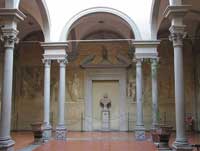 |
||||
Villa Celsa near Florence |
Piazza della Santissima Annunziata in Florence |
Choistro dello Scalzo, Florence |
||
| Piazza della Repubblica | History Roman forum Piazza della Repubblica marks the site of the forum, the centre of the Roman city. The exact present site of the Colonna dell'Abbondanza marks the intersection of the axes of the cardo (now via Roma, via degli Speziali and via degli Strozzi) and decumanus (now via il Corso). Foundations of a thermae complex on the south side and a religious building were found in the 19th-century demolition of the warren of medieval streets that had encroached upon the site. Via del Campidoglio and Via delle Terme, for example, were named after the archaeological remains beneath them. The chronicler Giovanni Villani reports an oral tradition that there was a temple to Mars on or near this site, and writes that Mars was the city's patron god and so determined the city's warlike character. According to Villani a statue of Mars was in the Middle Ages placed on the predecessor to the Ponte Vecchio, along with which it was swept away in the flood of 1333. Piazza del Mercato Vecchio and the Ghetto In the early medieval period the forum area was densely built over. Before the accomplishment of the fifth circle of city walls, the chroniclers record, there was no longer a single garden or pasturage in the city; there was so little space that urban development had to be not horizontal but vertical, in the case-torri (tower houses) soaring skywards. Over time, however, this area retained its function as a meeting place, to accommodate the market, which was institutionalised after 1000. As in other Italian towns, Florence came to define public space intended for commerce, with its complementary spaces nearby, the piazza del Duomo for political affairs and a piazza del Comune, now Piazza della Signoria, for political and civil affairs). In the 16th century the Mercato became the Mercato Vecchio on the completion of the Loggia del Mercato Nuovo near Ponte Vecchio. The Mercato Vecchio was a long, low building in an oval rectilinear plan, with an overhanging roof to shelter the customers and the stalls placed on either side. Other shops and stalls were sited in the piazzetta. The Mercato had numerous shrines and churches (now lost, but recorded in 18th century photographs, paintings and drawings housed in the Museo di Firenze com'era). On the piazzetta del Mercato was the church of Saint Thomas, and on the Campidoglio a church to Saint Mary. There was also the shrine of Santa Maria della Tromba, rebuilt in the north angle of Palazzo dell'Arte della Lana, on the back of Orsanmichele. Here also was to be found the Jewish Ghetto, where the Cosimo I had forced the city's Jews to live. It contained an Italian synagogue and a Spagnola or Levantine synagogue. It was thus a unique area of tightly packed streets and buildings, where over time medieval buildings survived intact. The sole witness to the old piazza del Mercato is the Colonna della Dovizia or Colonna dell'Abbondanza (Column of Abundance, re-positioned in 1956) on a stepped base. Considered to be the centre of the city, this column was erected at the crossing of the cardo and decumanus of the ancient Roman city. The present column dates to 1431, and is surmounted by a grey sandstone statue of Dovizia (or Abbondanza), by Giovan Battista Foggini, replacing an original by Donatello (found to be irreparably eroded in 1721. Today Foggini's original statue is in Palazzo della Cassa di Risparmio in via dell'Oriuolo, whilst on the column is a 1956 replica. The piazza "risanata" |
||||
The porticos with the triumphal arch, called the "Arcone", was designed by Micheli and was inspired by the most courtly Florentine Renaissance architecture, even if its additions to that style seem to be distant from the true ancient style. The pompous inscription that dominates the square was dictated, it seems, from Isidoro del Lungo, or another literary source: |
||||
| Choosing one of the Florence walking tours you'll be able to visit the world-famous museums of the Uffizi and Accademia Galleries, discovering the main historical and artistic treasures of the city. The tours focus on Florence's major sights and attractions, including the Duomo, the Ponte Vecchio and the city's famous churches and Renaissance palaces. Novelist Henry James called Florence a “rounded pearl of cities -- cheerful, compact, complete -- full of a delicious mixture of beauty and convenience.” The best way to experience the Italian city’s artistry, history and joy of life is by walking the same paths that the Medicis, Michelangelo and James once used. 1 | A Walk Around the Uffizi Gallery 2 | Quarter Duomo and Signoria Square 3 | Around Piazza della Repubblica 5 | San Niccolo Neighbourhood in Oltrarno 6 | Walking in the Bargello Neighbourhood 7 | From Fiesole to Settignano
|
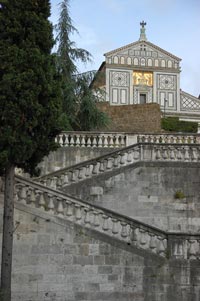 San Miniato al Monte |
|||
Palazzo Medici Riccardi, Florence |
Piazza della Santissima Annunziata in Florence |
Florence, Duomo |
||

